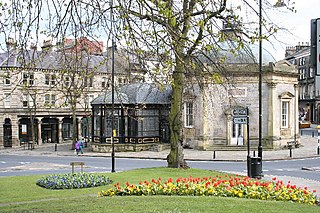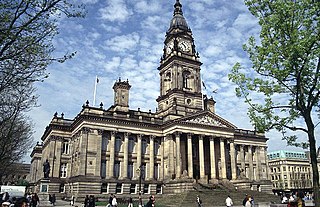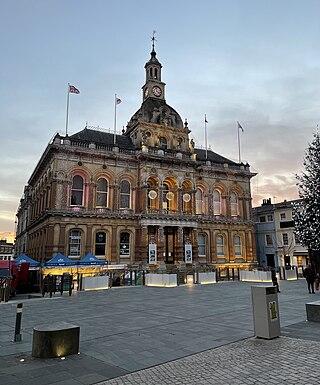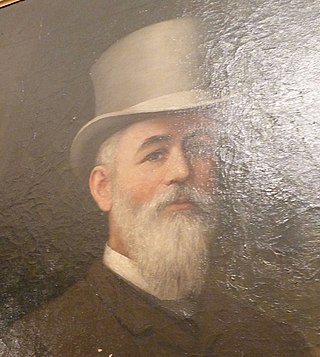
Harrogate is a spa town in the district and county of North Yorkshire, England. Historically in the West Riding of Yorkshire, the town is a tourist destination and its visitor attractions include its spa waters and RHS Harlow Carr gardens. 13 miles (21 km) away from the town centre is the Yorkshire Dales National Park and the Nidderdale AONB.

Leeds Civic Hall is a municipal building located in the civic quarter of Leeds, West Yorkshire, England. It replaced Leeds Town Hall as the administrative centre in 1933. The Civic Hall houses Leeds City Council offices, council chamber and a banqueting hall, and is a Grade II* listed building. A city landmark, two 2.3 metres high gold-leafed owls top its twin towers, decorations which are joined by four more owls on columns in Millennium Square, which sits to the front, and a gilded clock on both sides.

Denton Hall is an English country house located to the north of the River Wharfe, at Denton, Borough of Harrogate, North Yorkshire, England between Otley and Ilkley, and set within a larger Denton estate of about 2,500 acres (10 km2), including a village, church, and landscaped gardens. It is a Grade I listed building.

Wetherby Town Hall is a community building in Wetherby, West Yorkshire, England. The town hall no longer plays a major civic function but provides an office which is used by Wetherby Town Council and facilities for local groups and events. It is a Grade II listed building.

The Royal Pump Room is a Grade II* listed building in Harrogate, North Yorkshire, England. Today it houses the town's museum – operated by North Yorkshire Council. It was formerly a spa water pump house. It is located in Crown Place in the western part of Harrogate town centre, opposite the town's Valley Gardens park. It is bounded by two streets, Crescent Road and Royal Parade. Today, the Pump Room consists of both the original 1842 stone rotunda and a glazed annexe which was opened in 1913. The Pump Room offered guests of the town an all weather facility where they could drink sulphur water which was pumped on site from a natural spring known as the Old Sulphur Well. The building also had a social element to it as it provided guests with a place to meet friends and get to know others.

Bolton Town Hall in Victoria Square, Bolton, Greater Manchester, England, was built between 1866 and 1873 for the County Borough of Bolton to designs by William Hill of Leeds and George Woodhouse of Bolton. The town hall was extended in the 1930s to the designs of Bradshaw, Gass and Hope and has been designated a Grade II* listed building by English Heritage.

Ipswich Town Hall is a municipal building in Ipswich, in the county of Suffolk, England. It is a Grade II listed building. It is used for meetings of Ipswich Borough Council and also serves as an events venue and art gallery.

Isaac Thomas Shutt was an architect, a farmer, and the proprietor of the Old Swan Hotel, Harrogate, then in the West Riding of Yorkshire, England, from 1849 to 1879. In 1842, at the age of 24 years, he designed the Royal Pump Room, Harrogate, now a Grade II* listed building. In partnership with Alfred Hill Thompson he co-designed the Church of All Saints, Harlow Hill.

Pontefract Town Hall is a town hall in Pontefract, West Yorkshire, England. It was completed in 1882. It is now owned and used by Wakefield Council as a registry office. The building has been Grade II listed since 15 November 1988.

Lewisham Town Hall is a municipal building in Catford Road, Lewisham, London. The oldest part of the facility, the curved former municipal offices and adjoining concert hall of 1932, is a Grade II listed building. The complex also includes newer wings from the 1950s to 1970s; those serve as the headquarters of Lewisham London Borough Council.

Chingford Town Hall is a municipal building in The Ridgeway, Chingford, London. It is a locally listed building.

Scarborough Town Hall, originally St Nicholas House, is a red brick Jacobean Revival mansion in Scarborough, North Yorkshire, England, currently used as a municipal building for the Borough of Scarborough and an events venue. It was built in the 19th century as a home for John Woodall, a prominent local businessman, and then converted and extended for municipal use in 1903. Situated overlooking the South Bay, it is a grade II listed building.

Rotherham Town Hall is a municipal building in The Crofts, off Moorgate Street in Rotherham, South Yorkshire, England.

Chorley Town Hall is a municipal building in Market Street in Chorley, Lancashire, England.

Bridlington Town Hall is a municipal building in Quay Road, Bridlington, East Riding of Yorkshire, England. The town hall, which was the meeting place of Bridlington Borough Council, is a Grade II listed building. It now serves as an area office of East Riding of Yorkshire Council.

The Ripon Spa Baths are a grade II listed building in Ripon, North Yorkshire, England. It was built between 1904–05 as a spa but failed to compete with the larger facilities at nearby Harrogate. In 1936 a new pool was constructed to the rear and the facility converted to a swimming baths. The building is noted for its ornate terracotta-clad frontage and received listed building protection in 1980. Harrogate Borough Council proposed selling the building for housing development in 2008 on the grounds that it required significant structural repair. The sale was cancelled but in 2021 the council made a new proposal to sell the structure.

Malcolm George Neesam was an English historian and writer specialising in the history of Harrogate, North Yorkshire. He was also a librarian and archivist. His major works were the first two parts of a projected trilogy on that subject: Harrogate Great Chronicle, 1332–1841 (2005) and Wells and Swells: The Golden Age of Harrogate Spa, 1842–1923 (2022). The third part was to remain unfinished when he died, although his research papers are preserved in the Walker-Neesam Archive at the Mercer Art Gallery, Harrogate.

George Dawson was an English builder, property developer and alderman. The son of a village labourer, he was a self-made man who started as a cooper, became a rich entrepreneur and built himself a mansion.

David Simpson was an English builder, politician, property developer and contractor who was four times mayor of Harrogate, and three times deputy mayor. He developed the whole of the Duchy Estate, a major residential quarter for the rich, more than doubling the rateable value of the town in the first quarter of the 20th century. He was a member of Harrogate Borough Council for 34 years, making him the "father" of the council by the end of his career there. He was a justice of the peace and the first honorary Freeman of the Borough of Harrogate. He was president of the Bilton Ward Conservatives, a member of the Knaresborough Board of Guardians and an alderman of West Riding County Council. He built himself a large, castellated mansion called Oakdale, in 1903, besides the even larger Grand Hotel in Harrogate in the same year..

The Mercer Art Gallery, formerly the Mercer Gallery and locally known as The Mercer, is an art gallery in Harrogate, North Yorkshire, England. It was established in Lower Harrogate's Old Town Hall building in 1991. Owned by North Yorkshire Council, it has a collection of over 2,000 items, comprised mainly of 19th- to 21st-century artworks, including pieces by local artists. It hosts a rolling series of exhibitions of its own and borrowed artworks, keeping most of its own collection in storage for much of the time, or loaned out to exhibitions at other galleries, and to local establishments.






















